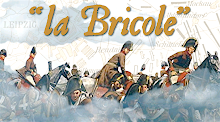Orders of Battle
A lot of time was spent on selecting an appropriate Order of Battle. In the end I relied mainly on the orbats found in the appendices of George Nafziger’s Napoleon at Leipzig and Napoleon at Dresden. It was clear that there were a lot of changes in the composition of Langeron’s Army Corps- and in the IXth Corps itself- in the time between the beginning of the Leipzig campaign and the invasion of France- this seems particularly to have been the case with the cavalry, where divisions were split up, separated, and reunited only to be split off again according to the strategic demands of the situation.
It was also very clear that attrition took its toll over the months, and the number of men- and of battalions- decreased steadily over time. On paper, a Russian division was to consist of up to six regiments for a total of fifteen battalions of 640 men each. By Leipzig, it seems the average Russian regiment consisted of about at no more than 475 effectives.
Again, what I was looking for was an organization that would give me a good-sized wargaming force, along with a reasonable contingent of cavalry to help fend off the minions of Napoleon. In the end, I settled for the orbat provided in the Leipzig book. The number of battalions in the division at that time, and the cavalry that made up the Advanced Guard under Rudsevitch, added up to a balanced and reasonable force (read: not TOO expensive) to collect.
There were some inconsistencies in some other sources. Digby Smith’s excellent book on the Battle of Leipzig has the Kursk regiment in place of the Iakoutski regiment in the 15th Infantry Division. While certainly there were some instances of regiments and even brigades being reassigned from one division to another (for example, the 12th and 22nd Jaegers were originally from the 13th Division), the Kursk Regiment should normally have been with the 10th Division under General Osten-Sacken. As the Iakoutski regiment “reappears” in later orbats with the 15th, and the 10th Division did not appear strong enough that it could “donate” battalions to other corps, I decided to stick with Nafziger and keep the Iakoutski as an original member of the line-up for the 15th Div. Besides, I already had the flag!
Still, as the Kursk regiment does not appear in any of the orbats for the 10th Division, I would be interested to know what happened to them- burned up at Lutzen and Bautzen, perhaps?
The artillery was another area where I had conflicting information, and many batteries seem to have been attached and re-attached to units, or put into reserve, depending (understandably) on the needs of the moment. Here I settled with Nafziger and decided to field two batteries, one heavy line battery and a light battery of the Horse Artillery. Likewise, I have included the third battalion of the Riajski Regiment, which sometime between the opening of the campaign and the battle of Leipzig, seemed to have disappeared from the order of battle- most likely being disbanded to provide reinforcements for the first battalion.














